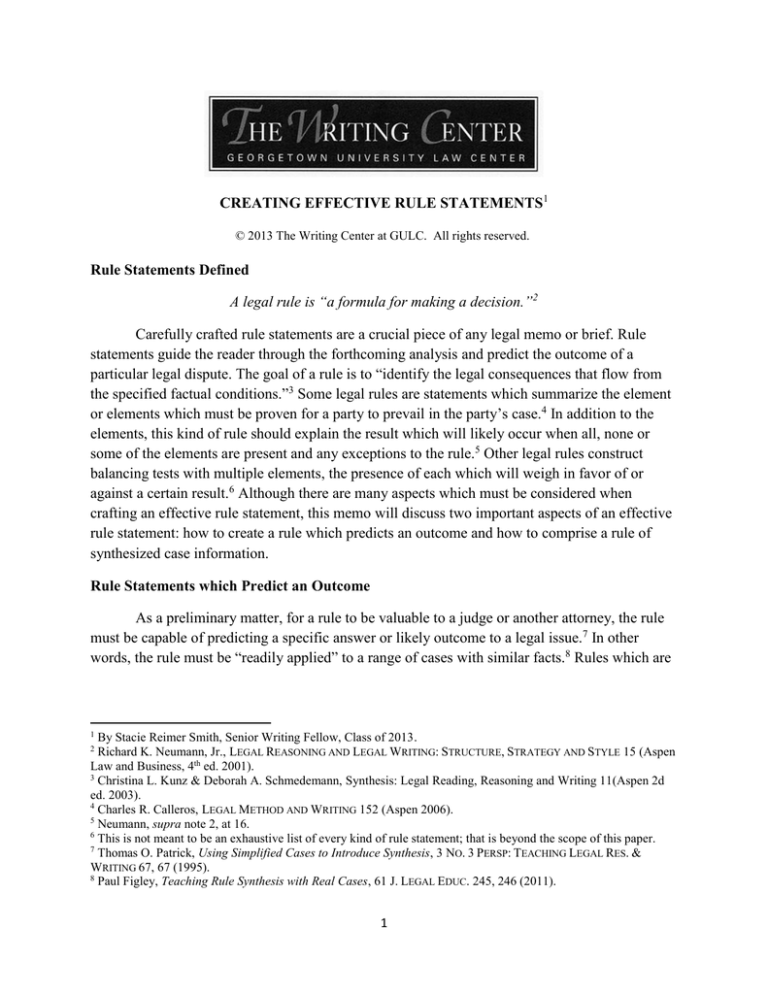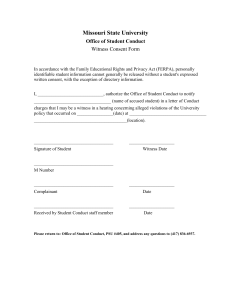
CREATING EFFECTIVE RULE STATEMENTS1
© 2013 The Writing Center at GULC. All rights reserved.
Rule Statements Defined
A legal rule is “a formula for making a decision.”2
Carefully crafted rule statements are a crucial piece of any legal memo or brief. Rule
statements guide the reader through the forthcoming analysis and predict the outcome of a
particular legal dispute. The goal of a rule is to “identify the legal consequences that flow from
the specified factual conditions.”3 Some legal rules are statements which summarize the element
or elements which must be proven for a party to prevail in the party’s case.4 In addition to the
elements, this kind of rule should explain the result which will likely occur when all, none or
some of the elements are present and any exceptions to the rule.5 Other legal rules construct
balancing tests with multiple elements, the presence of each which will weigh in favor of or
against a certain result.6 Although there are many aspects which must be considered when
crafting an effective rule statement, this memo will discuss two important aspects of an effective
rule statement: how to create a rule which predicts an outcome and how to comprise a rule of
synthesized case information.
Rule Statements which Predict an Outcome
As a preliminary matter, for a rule to be valuable to a judge or another attorney, the rule
must be capable of predicting a specific answer or likely outcome to a legal issue.7 In other
words, the rule must be “readily applied” to a range of cases with similar facts.8 Rules which are
1
By Stacie Reimer Smith, Senior Writing Fellow, Class of 2013.
Richard K. Neumann, Jr., LEGAL REASONING AND LEGAL WRITING: STRUCTURE, STRATEGY AND STYLE 15 (Aspen
Law and Business, 4th ed. 2001).
3
Christina L. Kunz & Deborah A. Schmedemann, Synthesis: Legal Reading, Reasoning and Writing 11(Aspen 2d
ed. 2003).
4
Charles R. Calleros, LEGAL METHOD AND WRITING 152 (Aspen 2006).
5
Neumann, supra note 2, at 16.
6
This is not meant to be an exhaustive list of every kind of rule statement; that is beyond the scope of this paper.
7
Thomas O. Patrick, Using Simplified Cases to Introduce Synthesis, 3 NO. 3 PERSP: TEACHING LEGAL RES. &
WRITING 67, 67 (1995).
8
Paul Figley, Teaching Rule Synthesis with Real Cases, 61 J. LEGAL EDUC. 245, 246 (2011).
2
1
vague and contain terms that are not easily defined often prevent a rule from predicting an
outcome.
Imagine that a lawyer is charged with creating a rule about eyewitness accuracy for an
appellate brief in a criminal case. The lawyer first writes the following rule statement:
“When a witness can get a ‘good look’ at the accused, then the court is likely to rule
that the witness’s testimony about the accused’s appearance is accurate.”
This rule does not easily predict an outcome. The phrase “good look” is not very descriptive:
various people could think of various definitions of “good look.” Perhaps the phrase “good look”
is even stated by judges in the case law. However, a stronger rule statement will define “good
look” in more concrete terms. The concrete terms can often be found by reading the case law
more closely and looking for measurable standards or amounts used by a judge. For example,
perhaps the case law defines “good look” factually, such as the ability of the witness to clearly
see all of the accused’s facial features. Incorporating a factually-based standard into the rule
statement will give your reader the exact parameters for finding a “good look” under the case
law. For example,
“If a witness is able to see all of the accused’s facial features clearly, then the witness’s
testimony is likely accurate.”
This second rule helps a judge predict a likely outcome based on a factual circumstance.
In this instance, a judge could ask herself “Did the witness see all of the accused facial features
accurately?” The answer to that question will determine the outcome on this particular element.
In short, remember to always give your reader a measurable standard that can be applied to
multiple cases.
Rule Synthesis: Definition
Synthesis is “the binding together of several opinions into a whole that stands for a rule
or expression of policy. By focusing on the reasoning and generic facts that the cases
have in common, synthesis finds and explains collective meaning that is not apparent
from the individual cases themselves.”9
Secondly, case law on a particular issue dictates that a synthesized rule must be created.
Sometimes rules can consist of a statute or a controlling case which is directly on point with the
legal dispute at issue and this statute or case rule can be quoted or paraphrased as the guiding
rule.10 This typically happens when a legislature has created a statute which addresses the exact
issue of the case definitively or the highest level appellate court in the jurisdiction has a clear and
9
Richard K. Neumann Jr., LEGAL REASONING AND LEGAL WRITING: STRUCTURE, STRATEGY AND STYLE 123
(Aspen Law and Business, 2d ed. 1994).
10
Paul Figley at 245.
2
currently controlling ruling on this issue.11 However, stating a rule is not usually this easy.12
Often for a rule statement to be effective, the rule statement must synthesize a principle from the
body of case law which is relevant to the issue at hand.13
Many legal research and writing professors agree that legal synthesis is the “backbone of
basic legal analysis”14 and one of the vital skills necessary to be a successful lawyer.15
Oftentimes, students who are new to legal writing will pick a quotation from one case which
appears to be the statement of the law on a particular issue.16 However, a rule which applies to a
legal issue will rarely be comprised of information from one case or one statute only.17 Instead, a
rule which applies to a legal dispute is often the “product of a synthesis of multiple
authorities.”18 Other students may find multiple statements of aspects of a legal rule in various
cases and introduce those rules one at a time throughout the analysis.19 However, this
“successive analysis” approach will not best serve a client or an attorney supervisor because this
approach fails to provide a coherent standard. Given that the goal of legal writing often is to
predict the way a court will rule on a dispute in the future, the analysis is strengthened by
creating rule statements that synthesize all the relevant information from various sources into a
coherent standard.20 Furthermore, this kind of successive analysis will make the judge’s job very
difficult. Because a judge is bound to decide cases based on stare decisis, it is the lawyer’s job to
give the judge the entire picture of the state of the law in one, easily understandable standard.21
Rule Synthesis: Examples
A synthesized rule statement brings all the rule material presented in a particular section
into one place, preferably into one sentence at or near the beginning of a section. As an example,
imagine that the same lawyer from the example above concludes that she needs to write a
synthesized rule statement for her appellate brief. There is no relevant statute or a binding
appellate case which clearly defines the rule for the accuracy of eyewitness accounts in this
jurisdiction. The lawyer would like to craft a synthesized rule statement which will combine
information from the various relevant case law in this jurisdiction. The lawyer has found the
following rule statements from the relevant case law:
11
Jane Kent Gionfriddo, Thinking Like a Lawyer: The Heuristics of Case Synthesis, 40 TEX. TECH. L. REVIEW 1, 5
(2007).
12
Figley, supra note 8, at 246.
13
Figley, supra note 8, at 245.
14
Clifford Zimmerman, Creative Ideas and Techniques for Teaching Rule Synthesis, 8 NO. 2 PERSP: TEACHING
LEGAL RES. & WRITING 68, 68, (2000).
15
Linda Levine & Kurt M. Saunders, Learning to Think Like a Lawyer, 29 U.S.F. L. REV. 121, 126 (1994).
16
Id.
17
Calleros, supra note 4, at 77.
18
Id. at 87.
19
Figley, supra note 8, at 245.
20
Calleros, supra note 4, at 87.
21
Gionfriddo, supra note 11, at 5.
3
If a witness is able to see all of the accused’s facial features clearly, then the
witness’s testimony is likely accurate.
For a witness’s testimony to be accurate, the witness must see the accused’s face for
longer than a few seconds.
Although not necessary, a witness who views a crime during bright daylight is
assumed to have a more accurate testimony than a witness who views a crime at
night.
One valid approach is to take these rule statements and list them in succession. For example:
“If a witness is able to see all of the accused’s facial features clearly, then the witness’s
testimony is likely accurate. Furthermore, for a witness’s testimony to be accurate, the
witness must see the accused’s face for longer than a few seconds. Finally, although not
necessary, a witness who views a crime during bright daylight is assumed to have a more
accurate testimony than a witness who views a crime at night.”
However, this construction above uses a lot of words, 80 to be exact. Furthermore, it might be
confusing for a reader to read through three different rule statements one after another. A better
method is to synthesize all three statements into one overall statement, giving the reader the full
standard in one sentence. For example:
“If a witness is able to see all of the accused’s facial features clearly for longer than
a few seconds, then the witness’s testimony is likely accurate, especially when the incident
occurs during bright daylight.”
This rule statement incorporates all the parts of the standard in just 35 words. Rule
statements like these can be used as clear roadmaps at the beginning of sections as well.
Remember to cite within the rule statement after each individual proposition.
Conclusion
Although this memo is not an exhaustive guide to writing rule statements, a student who
creates rules which clearly predict a judicial outcome and which synthesize case law from
multiple sources will be well on her way to creating effective rule statements.
4

